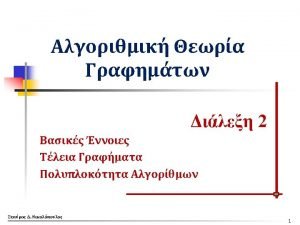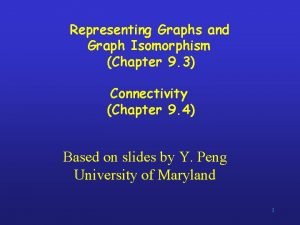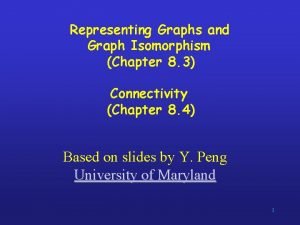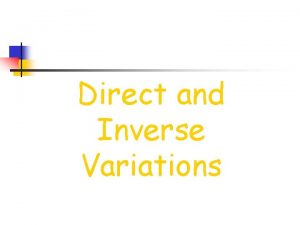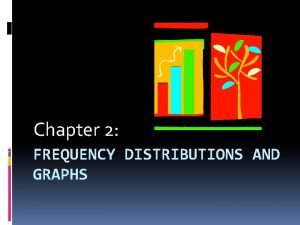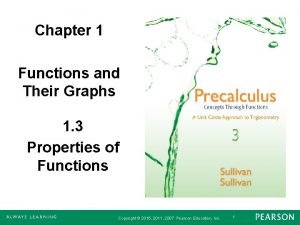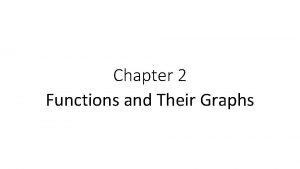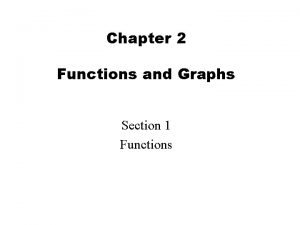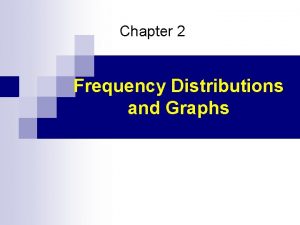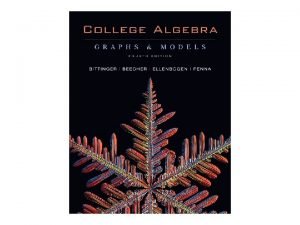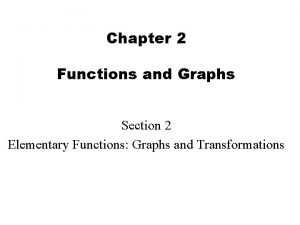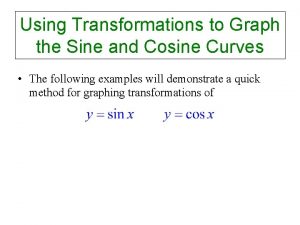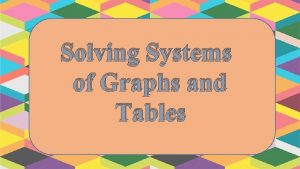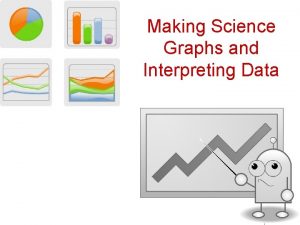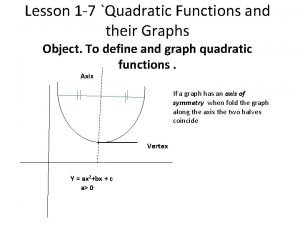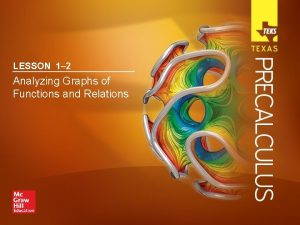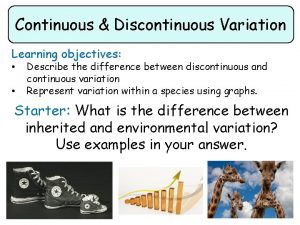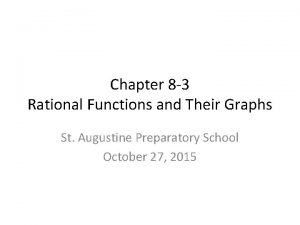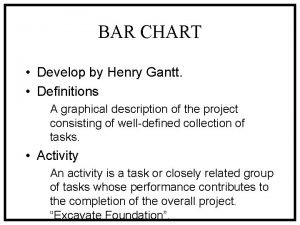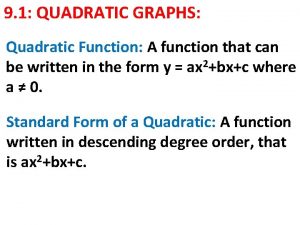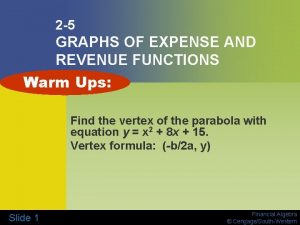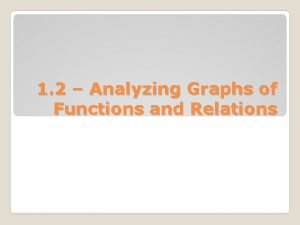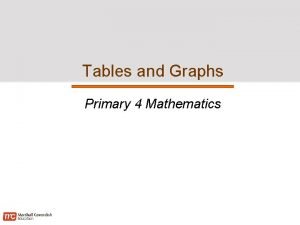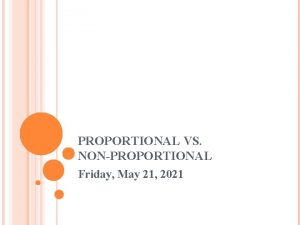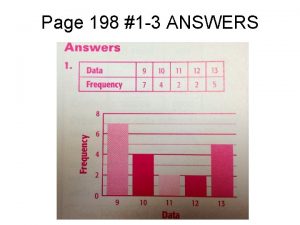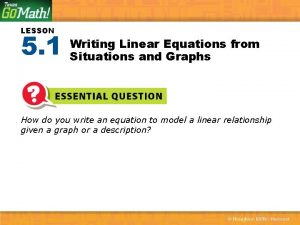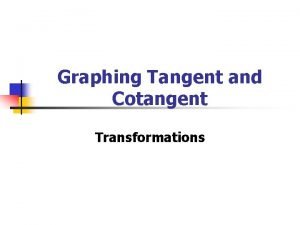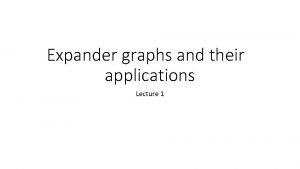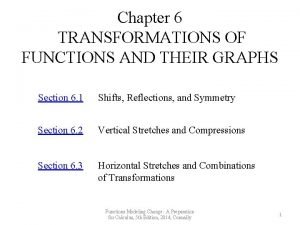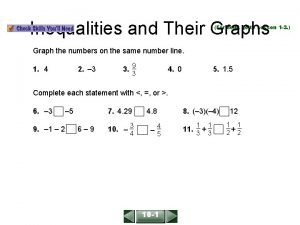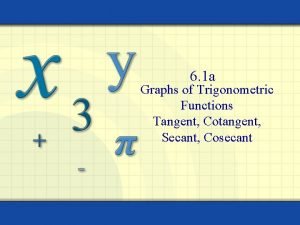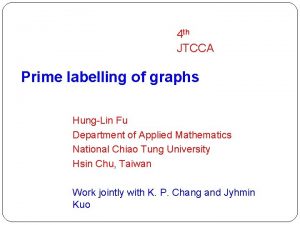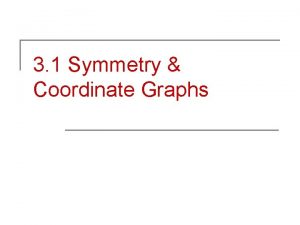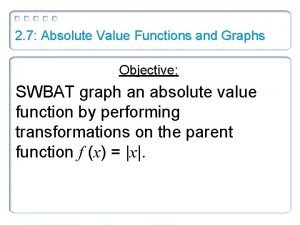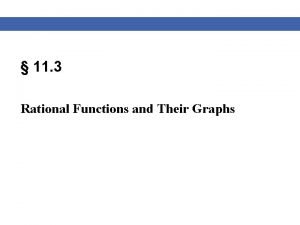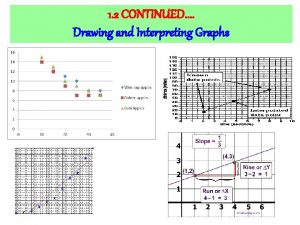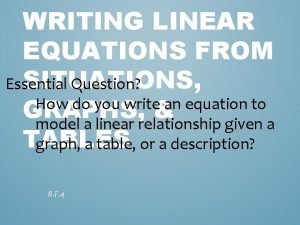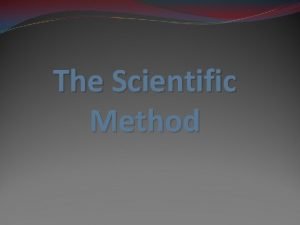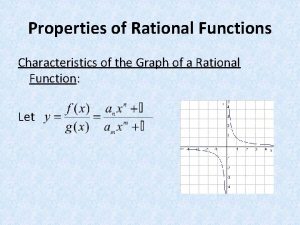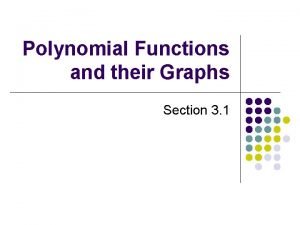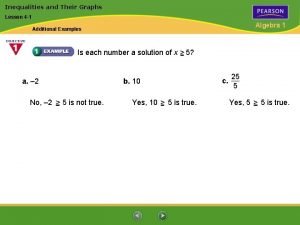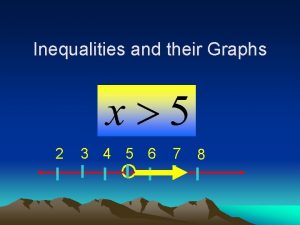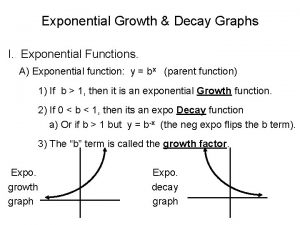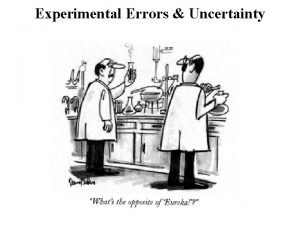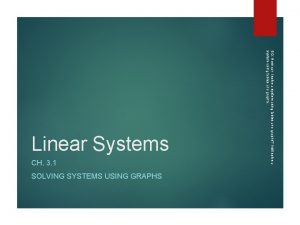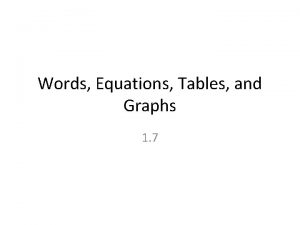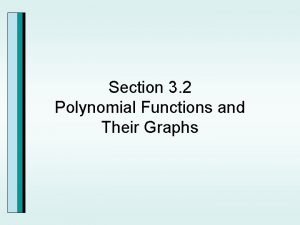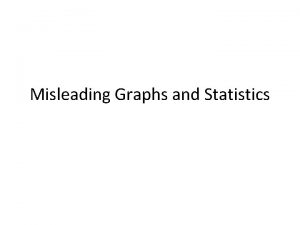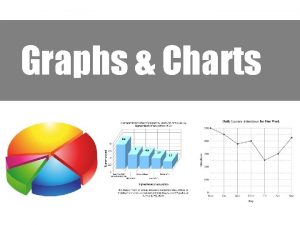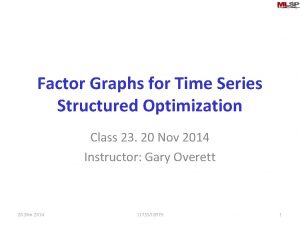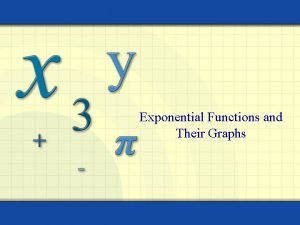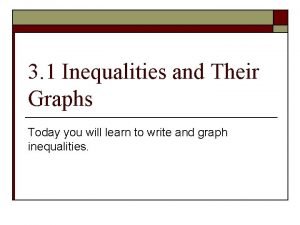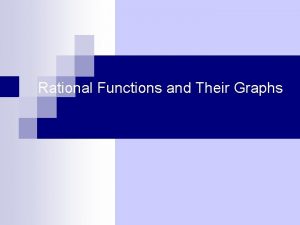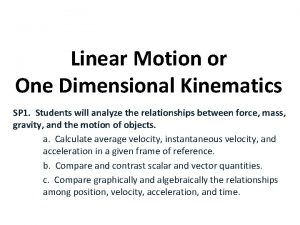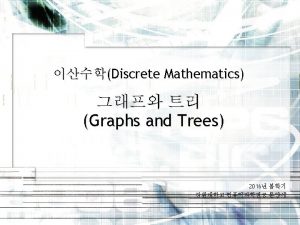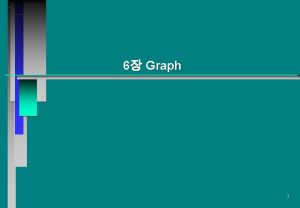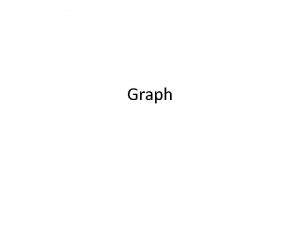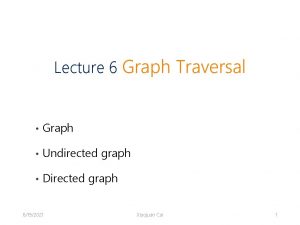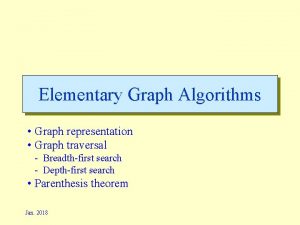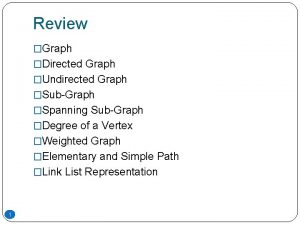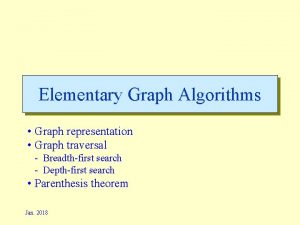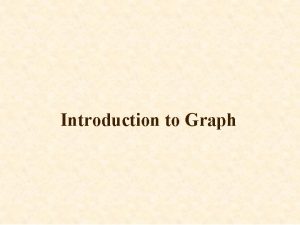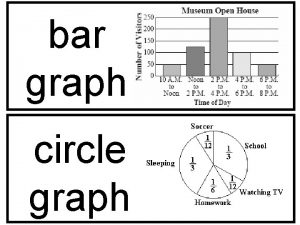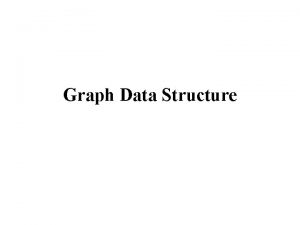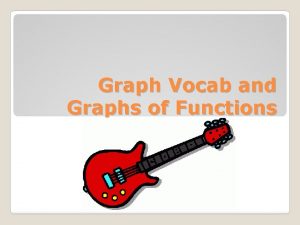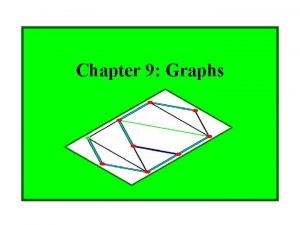Graphs Chapter 10 Chapter Summary Graphs and Graph
























































































- Slides: 88

Graphs Chapter 10

Chapter Summary �Graphs and Graph Models �Graph Terminology and Special Types of Graphs �Representing Graphs and Graph Isomorphism �Connectivity �Euler and Hamiltonian Graphs �Shortest-Path Problems (not currently included in overheads) �Planar Graphs (not currently included in overheads) �Graph Coloring (not currently included in overheads)

Graphs and Graph Models Section 10. 1

Section Summary �Introduction to Graphs �Graph Taxonomy �Graph Models

Graphs Definition: A graph G = (V, E) consists of a nonempty set V of vertices (or nodes) and a set E of edges. Each edge has either one or two vertices associated with it, called its endpoints. An edge is said to connect its endpoints. Example: This is a graph with four vertices and five edges. a b d c Remarks: � The graphs we study here are unrelated to graphs of functions studied in Chapter 2. � We have a lot of freedom when we draw a picture of a graph. All that matters is the connections made by the edges, not the particular geometry depicted. For example, the lengths of edges, whether edges cross, how vertices are depicted, and so on, do not matter � A graph with an infinite vertex set is called an infinite graph. A graph with a finite vertex set is called a finite graph. We (following the text) restrict our attention to finite graphs.

Some Terminology � In a simple graph each edge connects two different vertices and no two edges connect the same pair of vertices. � Multigraphs may have multiple edges connecting the same two vertices. When m different edges connect the vertices u and v, we say that {u, v} is an edge of multiplicity m. � An edge that connects a vertex to itself is called a loop. � A pseudograph may include loops, as well as multiple edges connecting the same pair of vertices. Example: This pseudograph has both multiple edges and a loop. a b c Remark: There is no standard terminology for graph theory. So, it is crucial that you understand the terminology being used whenever you read material about graphs.

Directed Graphs Definition: An directed graph (or digraph) G = (V, E) consists of a nonempty set V of vertices (or nodes) and a set E of directed edges (or arcs). Each edge is associated with an ordered pair of vertices. The directed edge associated with the ordered pair (u, v) is said to start at u and end at v. Remark: �Graphs where the end points of an edge are not ordered are said to be undirected graphs.

Some Terminology (continued) � A simple directed graph has no loops and no multiple edges. Example: This is a directed graph with three vertices and four edges. b a c � A directed multigraph may have multiple directed edges. When there are m directed edges from the vertex u to the vertex v, we say that (u, v) is an edge of multiplicity m. Example: In this directed multigraph the multiplicity of (a, b) is 1 and the multiplicity of (b, c) is 2. b a c

Graph Models: Computer Networks � When we build a graph model, we use the appropriate type of graph to capture the important features of the application. � We illustrate this process using graph models of different types of computer networks. In all these graph models, the vertices represent data centers and the edges represent communication links. � To model a computer network where we are only concerned whether two data centers are connected by a communications link, we use a simple graph. This is the appropriate type of graph when we only care whether two data centers are directly linked (and not how many links there may be) and all communications links work in both directions.

Graph Models: Computer Networks (continued) • To model a computer network where we care about the number of links between data centers, we use a multigraph. • To model a computer network with diagnostic links at data centers, we use a pseudograph, as loops are needed. • To model a network with multiple oneway links, we use a directed multigraph. Note that we could use a directed graph without multiple edges if we only care whethere is at least one link from a data center to another data center.

Graph Terminology: Summary �To understand the structure of a graph and to build a graph model, we ask these questions: • Are the edges of the graph undirected or directed (or both)? • If the edges are undirected, are multiple edges present that connect the same pair of vertices? If the edges are directed, are multiple directed edges present? • Are loops present?

Other Applications of Graphs �We will illustrate how graph theory can be used in models of: �Social networks �Communications networks �Information networks �Software design �Transportation networks �Biological networks �It’s a challenge to find a subject to which graph theory has not yet been applied. Can you find an area without applications of graph theory?

Graph Models: Social Networks �Graphs can be used to model social structures based on different kinds of relationships between people or groups. �In a social network, vertices represent individuals or organizations and edges represent relationships between them. �Useful graph models of social networks include: �friendship graphs - undirected graphs where two people are connected if they are friends (in the real world, on Facebook, or in a particular virtual world, and so on. ) �collaboration graphs - undirected graphs where two people are connected if they collaborate in a specific way �influence graphs - directed graphs where there is an edge from one person to another if the first person can influence the second person

Graph Models: Social Networks (continued) Example: A friendship graph where two people are connected if they are Facebook friends. Example: An influence graph Next Slide: Collaboration Graphs

Examples of Collaboration Graphs �The Hollywood graph models the collaboration of actors in films. � We represent actors by vertices and we connect two vertices if the actors they represent have appeared in the same movie. � We will study the Hollywood Graph in Section 10. 4 when we discuss Kevin Bacon numbers. �An academic collaboration graph models the collaboration of researchers who have jointly written a paper in a particular subject. � We represent researchers in a particular academic discipline using vertices. � We connect the vertices representing two researchers in this discipline if they are coauthors of a paper. � We will study the academic collaboration graph for mathematicians when we discuss Erdős numbers in Section 10. 4.

Applications to Information Networks �Graphs can be used to model different types of networks that link different types of information. �In a web graph, web pages are represented by vertices and links are represented by directed edges. � A web graph models the web at a particular time. � We will explain how the web graph is used by search engines in Section 11. 4. �In a citation network: � Research papers in a particular discipline are represented by vertices. �When a paper cites a second paper as a reference, there is an edge from the vertex representing this paper to the vertex representing the second paper.

Transportation Graphs �Graph models are extensively used in the study of transportation networks. �Airline networks can be modeled using directed multigraphs where �airports are represented by vertices �each flight is represented by a directed edge from the vertex representing the departure airport to the vertex representing the destination airport �Road networks can be modeled using graphs where �vertices represent intersections and edges represent roads. �undirected edges represent two-way roads and directed edges represent one-way roads.

Software Design Applications � Graph models are extensively used in software design. We will introduce two such models here; one representing the dependency between the modules of a software application and the other representing restrictions in the execution of statements in computer programs. � When a top-down approach is used to design software, the system is divided into modules, each performing a specific task. � We use a module dependency graph to represent the dependency between these modules. These dependencies need to be understood before coding can be done. � In a module dependency graph vertices represent software modules and there is an edge from one module to another if the second module depends on the first. Example: The dependencies between the seven modules in the design of a web browser are represented by this module dependency graph.

Software Design Applications (continued) �We can use a directed graph called a precedence graph to represent which statements must have already been executed before we execute each statement. � Vertices represent statements in a computer program �There is a directed edge from a vertex to a second vertex if the second vertex cannot be executed before the first Example: This precedence graph shows which statements must already have been executed before we can execute each of the six statements in the program.

Biological Applications �Graph models are used extensively in many areas of the biological science. We will describe two such models, one to ecology and the other to molecular biology. �Niche overlap graphs model competition between species in an ecosystem �Vertices represent species and an edge connects two vertices when they represent species who compete for food resources. Example: This is the niche overlap graph for a forest ecosystem with nine species.

Biological Applications (continued) � We can model the interaction of proteins in a cell using a protein interaction network. � In a protein interaction graph, vertices represent proteins and vertices are connected by an edge if the proteins they represent interact. � Protein interaction graphs can be huge and can contain more than 100, 000 vertices, each representing a different protein, and more than 1, 000 edges, each representing an interaction between proteins � Protein interaction graphs are often split into smaller graphs, called modules, which represent the interactions between proteins involved in a particular function. Example: This is a module of the protein interaction graph of proteins that degrade RNA in a human cell.

Graph Terminology and Special Types of Graphs Section 10. 2

Section Summary �Basic Terminology �Some Special Types of Graphs �Bipartite Graphs and Matchings (not currently included in overheads) �Some Applications of Special Types of Graphs (not currently included in overheads) �New Graphs from Old

Basic Terminology Definition 1. Two vertices u, v in an undirected graph G are called adjacent (or neighbors) in G if there is an edge e between u and v. Such an edge e is called incident with the vertices u and v and e is said to connect u and v. Definition 2. The set of all neighbors of a vertex v of G = (V, E), denoted by N(v), is called the neighborhood of v. If A is a subset of V, we denote by N(A) the set of all vertices in G that are adjacent to at least one vertex in A. So, Definition 3. The degree of a vertex in a undirected graph is the number of edges incident with it, except that a loop at a vertex contributes two to the degree of that vertex. The degree of the vertex v is denoted by deg(v).

Degrees and Neighborhoods of Vertices Example: What are the degrees and neighborhoods of the vertices in the graphs G and H? Solution: G: deg(a) = 2, deg(b) = deg(c) = deg(f ) = 4, deg(d ) = 1, deg(e) = 3, deg(g) = 0. N(a) = {b, f }, N(b) = {a, c, e, f }, N(c) = {b, d, e, f }, N(d) = {c}, N(e) = {b, c , f }, N(f) = {a, b, c, e}, N(g) = . H: deg(a) = 4, deg(b) = deg(e) = 6, deg(c) = 1, deg(d) = 5. N(a) = {b, d, e}, N(b) = {a, b, c, d, e}, N(c) = {b}, N(d) = {a, b, e}, N(e) = {a, b , d}.

Degrees of Vertices �

Handshaking Theorem We now give two examples illustrating the usefulness of the handshaking theorem. Example: How many edges are there in a graph with 10 vertices of degree six? Solution: Because the sum of the degrees of the vertices is 6 10 = 60, the handshaking theorem tells us that 2 m = 60. So the number of edges m = 30. Example: If a graph has 5 vertices, can each vertex have degree 3? Solution: This is not possible by the handshaking thorem, because the sum of the degrees of the vertices 3 5 = 15 is odd.

Degree of Vertices (continued) Theorem 2: An undirected graph has an even number of vertices of odd degree. Proof: Let V 1 be the vertices of even degree and V 2 be the vertices of odd degree in an undirected graph G = (V, E) with m edges. Then even must be even since deg(v) is even for each v ∈ V 1 This sum must be even because 2 m is even and the sum of the degrees of the vertices of even degrees is also even. Because this is the sum of the degrees of all vertices of odd degree in the graph, there must be an even number of such vertices.

Directed Graphs Recall the definition of a directed graph. Definition: An directed graph G = (V, E) consists of V, a nonempty set of vertices (or nodes), and E, a set of directed edges or arcs. Each edge is an ordered pair of vertices. The directed edge (u, v) is said to start at u and end at v. Definition: Let (u, v) be an edge in G. Then u is the initial vertex of this edge and is adjacent to v and v is the terminal (or end) vertex of this edge and is adjacent from u. The initial and terminal vertices of a loop are the same.

Directed Graphs (continued) Definition: The in-degree of a vertex v, denoted deg−(v), is the number of edges which terminate at v. The out-degree of v, denoted deg+(v), is the number of edges with v as their initial vertex. Note that a loop at a vertex contributes 1 to both the in-degree and the out-degree of the vertex. Example: In the graph G we have deg−(a) = 2, deg−(b) = 2, deg−(c) = 3, deg−(d) = 2, deg−(e) = 3, deg−(f) = 0. deg+(a) = 4, deg+(b) = 1, deg+(c) = 2, deg+(d) = 2, deg+ (e) = 3, deg+(f) = 0.

Directed Graphs (continued) Theorem 3: Let G = (V, E) be a graph with directed edges. Then: Proof: The first sum counts the number of outgoing edges over all vertices and the second sum counts the number of incoming edges over all vertices. It follows that both sums equal the number of edges in the graph.

Special Types of Simple Graphs: Complete Graphs A complete graph on n vertices, denoted by Kn, is the simple graph that contains exactly one edge between each pair of distinct vertices.

Special Types of Simple Graphs: Cycles and Wheels A cycle Cn for n ≥ 3 consists of n vertices v 1, v 2 , ⋯ , vn, and edges {v 1, v 2}, {v 2, v 3} , ⋯ , {vn-1, vn}, {vn, v 1}. A wheel Wn is obtained by adding an additional vertex to a cycle Cn for n ≥ 3 and connecting this new vertex to each of the n vertices in Cn by new edges.

Special Types of Simple Graphs: n-Cubes An n-dimensional hypercube, or n-cube, Qn, is a graph with 2 n vertices representing all bit strings of length n, where there is an edge between two vertices that differ in exactly one bit position.

Special Types of Graphs and Computer Network Architecture Various special graphs play an important role in the design of computer networks. � Some local area networks use a star topology, which is a complete bipartite graph K 1, n , as shown in (a). All devices are connected to a central control device. � Other local networks are based on a ring topology, where each device is connected to exactly two others using Cn , as illustrated in (b). Messages may be sent around the ring. � Others, as illustrated in (c), use a Wn – based topology, combining the features of a star topology and a ring topology. � Various special graphs also play a role in parallel processing where processors need to be interconnected as one processor may need the output generated by another. � The n-dimensional hypercube, or n-cube, Qn, is a common way to connect processors in parallel, e. g. , Intel Hypercube. � Another common method is the mesh network, illustrated here for 16 processors.

Bipartite Graphs Definition: A simple graph G is bipartite if V can be partitioned into two disjoint subsets V 1 and V 2 such that every edge connects a vertex in V 1 and a vertex in V 2. In other words, there are no edges which connect two vertices in V 1 or in V 2. It is not hard to show that an equivalent definition of a bipartite graph is a graph where it is possible to color the vertices red or blue so that no two adjacent vertices are the same color. G is bipartite H is not bipartite since if we color a red, then the adjacent vertices f and b must both be blue.

Bipartite Graphs (continued) Example: Show that C 6 is bipartite. Solution: We can partition the vertex set into V 1 = {v 1, v 3, v 5} and V 2 = {v 2, v 4, v 6} so that every edge of C 6 connects a vertex in V 1 and V 2. Example: Show that C 3 is not bipartite. Solution: If we divide the vertex set of C 3 into two nonempty sets, one of the two must contain two vertices. But in C 3 every vertex is connected to every other vertex. Therefore, the two vertices in the same partition are connected. Hence, C 3 is not bipartite.

Complete Bipartite Graphs Definition: A complete bipartite graph Km, n is a graph that has its vertex set partitioned into two subsets V 1 of size m and V 2 of size n such that there is an edge from every vertex in V 1 to every vertex in V 2. Example: We display four complete bipartite graphs here.

New Graphs from Old Definition: A subgraph of a graph G = (V, E) is a graph (W, F), where W ⊂ V and F ⊂ E. A subgraph H of G is a proper subgraph of G if H ≠ G. Example: Here we show K 5 and one of its subgraphs. Definition: Let G = (V, E) be a simple graph. The subgraph induced by a subset W of the vertex set V is the graph (W, F), where the edge set F contains an edge in E if and only if both endpoints are in W. Example: Here we show K 5 and the subgraph induced by W = {a, b, c, e}.

Bipartite Graphs and Matchings � Bipartite graphs are used to model applications that involve matching the elements of one set to elements in another, for example: � Job assignments - vertices represent the jobs and the employees, edges link employees with those jobs they have been trained to do. A common goal is to match jobs to employees so that the most jobs are done. � Marriage - vertices represent the men and the women and edges link a a man and a woman if they are an acceptable spouse. We may wish to find the largest number of possible marriages. See the text for more about matchings in bipartite graphs.

New Graphs from Old (continued) Definition: The union of two simple graphs G 1 = (V 1, E 1) and G 2 = (V 2, E 2) is the simple graph with vertex set V 1 ⋃ V 2 and edge set E 1 ⋃ E 2. The union of G 1 and G 2 is denoted by G 1 ⋃ G 2. Example:

Representing Graphs and Graph Isomorphism Section 10. 3

Section Summary �Adjacency Lists �Adjacency Matrices �Incidence Matrices �Isomorphism of Graphs

Representing Graphs: Adjacency Lists Definition: An adjacency list can be used to represent a graph with no multiple edges by specifying the vertices that are adjacent to each vertex of the graph. Example:

Representation of Graphs: Adjacency Matrices Definition: Suppose that G = (V, E) is a simple graph where |V| = n. Arbitrarily list the vertices of G as v 1, v 2, … , vn. The adjacency matrix AG of G, with respect to the listing of vertices, is the n × n zero-one matrix with 1 as its (i, j)th entry when vi and vj are adjacent, and 0 as its (i, j)th entry when they are not adjacent. �In other words, if the graphs adjacency matrix is AG = [aij], then

Adjacency Matrices (continued) Example: When a graph is sparse, that is, it has few edges relatively to the total number of possible edges, it The ordering of is much more efficient to vertices is a, b, c, d. represent the graph using an adjacency list than an adjacency matrix. But for a dense graph, which The ordering of vertices is a, b, c, d. includes a high percentage of possible edges, an adjacency matrix is preferable. Note: The adjacency matrix of a simple graph is symmetric, i. e. , aij = aji Also, since there are no loops, each diagonal entry aij for i = 1, 2, 3, …, n, is 0.

Adjacency Matrices (continued) �Adjacency matrices can also be used to represent graphs with loops and multiple edges. �A loop at the vertex vi is represented by a 1 at the (i, j)th position of the matrix. �When multiple edges connect the same pair of vertices vi and vj, (or if multiple loops are present at the same vertex), the (i, j)th entry equals the number of edges connecting the pair of vertices. Example: We give the adjacency matrix of the pseudograph shown here using the ordering of vertices a, b, c, d.

Adjacency Matrices (continued) �Adjacency matrices can also be used to represent directed graphs. The matrix for a directed graph G = (V, E) has a 1 in its (i, j)th position if there is an edge from vi to vj, where v 1, v 2, … vn is a list of the vertices. � In other words, if the graphs adjacency matrix is AG = [aij], then � The adjacency matrix for a directed graph does not have to be symmetric, because there may not be an edge from vi to vj, when there is an edge from vj to vi. To represent directed multigraphs, the value of aij is the number of edges connecting vi to vj. �

Representation of Graphs: Incidence Matrices Definition: Let G = (V, E) be an undirected graph with vertices where v 1, v 2, … vn and edges e 1, e 2, … em. The incidence matrix with respect to the ordering of V and E is the n × m matrix M = [mij], where

Incidence Matrices (continued) Example: Simple Graph and Incidence Matrix The rows going from top to bottom represent v 1 through v 5 and the columns going from left to right represent e 1 through e 6. Example: Pseudograph and Incidence Matrix The rows going from top to bottom represent v 1 through v 5 and the columns going from left to right represent e 1 through e 8.

Isomorphism of Graphs Definition: The simple graphs G 1 = (V 1, E 1) and G 2 = (V 2, E 2) are isomorphic if there is a one-to-one and onto function f from V 1 to V 2 with the property that a and b are adjacent in G 1 if and only if f(a) and f(b) are adjacent in G 2 , for all a and b in V 1. Such a function f is called an isomorphism. Two simple graphs that are not isomorphic are called nonisomorphic.

Isomorphism of Graphs (cont. ) Example: Show that the graphs G =(V, E) and H = (W, F) are isomorphic. Solution: The function f with f(u 1) = v 1, f(u 2) = v 4, f(u 3) = v 3, and f(u 4) = v 2 is a one-to-one correspondence between V and W. Note that adjacent vertices in G are u 1 and u 2, u 1 and u 3, u 2 and u 4, and u 3 and u 4. Each of the pairs f(u 1) = v 1 and f(u 2) = v 4, f(u 1) = v 1 and f(u 3) = v 3 , f(u 2) = v 4 and f(u 4) = v 2 , and f(u 3) = v 3 and f(u 4) = v 2 consists of two adjacent vertices in H.

Isomorphism of Graphs (cont. ) � It is difficult to determine whether two simple graphs are isomorphic using brute force because there are n! possible one-to-one correspondences between the vertex sets of two simple graphs with n vertices. � The best algorithms for determining weather two graphs are isomorphic have exponential worst case complexity in terms of the number of vertices of the graphs. � Sometimes it is not hard to show that two graphs are not isomorphic. We can do so by finding a property, preserved by isomorphism, that only one of the two graphs has. Such a property is called graph invariant. � There are many different useful graph invariants that can be used to distinguish nonisomorphic graphs, such as the number of vertices, number of edges, and degree sequence (list of the degrees of the vertices in nonincreasing order). We will encounter others in later sections of this chapter.

Isomorphism of Graphs (cont. ) Example: Determine whether these two graphs are isomorphic. Solution: Both graphs have eight vertices and ten edges. They also both have four vertices of degree two and four of degree three. However, G and H are not isomorphic. Note that since deg(a) = 2 in G, a must correspond to t, u, x, or y in H, because these are the vertices of degree 2. But each of these vertices is adjacent to another vertex of degree two in H, which is not true for a in G. Alternatively, note that the subgraphs of G and H made up of vertices of degree three and the edges connecting them must be isomorphic. But the subgraphs, as shown at the right, are not isomorphic.

Isomorphism of Graphs (cont. ) Example: Determine whether these two graphs are isomorphic. Solution: Both graphs have six vertices and seven edges. They also both have four vertices of degree two and two of degree three. The subgraphs of G and H consisting of all the vertices of degree two and the edges connecting them are isomorphic. So, it is reasonable to try to find an isomorphism f. We define an injection f from the vertices of G to the vertices of H that preserves the degree of vertices. We will determine whether it is an isomorphism. The function f with f(u 1) = v 6, f(u 2) = v 3, f(u 3) = v 4, and f(u 4) = v 5 , f(u 5) = v 1, and f(u 6) = v 2 is a one-to-one correspondence between G and H. Showing that this correspondence preserves edges is straightforward, so we will omit the details here. Because f is an isomorphism, it follows that G and H are isomorphic graphs. See the text for an illustration of how adjacency matrices can be used for this verification.

Algorithms for Graph Isomorphism �The best algorithms known for determining whether two graphs are isomorphic have exponential worst-case time complexity (in the number of vertices of the graphs). �However, there algorithms with linear average-case time complexity. �You can use a public domain program called NAUTY to determine in less than a second whether two graphs with as many as 100 vertices are isomoprhic. �Graph isomorphism is a problem of special interest because it is one of a few NP problems not known to be either tractable or NP-complete (see Section 3. 3).

Applications of Graph Isomorphism �The question whether graphs are isomorphic plays an important role in applications of graph theory. For example, � chemists use molecular graphs to model chemical compounds. Vertices represent atoms and edges represent chemical bonds. When a new compound is synthesized, a database of molecular graphs is checked to determine whether the graph representing the new compound is isomorphic to the graph of a compound that this already known. � Electronic circuits are modeled as graphs in which the vertices represent components and the edges represent connections between them. Graph isomorphism is the basis for � the verification that a particular layout of a circuit corresponds to the design’s original schematics. � determining whether a chip from one vendor includes the intellectual property of another vendor.

Connectivity Section 10. 4

Section Summary �Paths �Connectedness in Undirected Graphs �Vertex Connectivity and Edge Connectivity (not currently included in overheads) �Connectedness in Directed Graphs �Paths and Isomorphism (not currently included in overheads) �Counting Paths between Vertices

Paths Informal Definition: A path is a sequence of edges that begins at a vertex of a graph and travels from vertex to vertex along edges of the graph. As the path travels along its edges, it visits the vertices along this path, that is, the endpoints of these. Applications: Numerous problems can be modeled with paths formed by traveling along edges of graphs such as: � determining whether a message can be sent between two computers. � efficiently planning routes for mail delivery.

Paths Definition: Let n be a nonnegative integer and G an undirected graph. A path of length n from u to v in G is a sequence of n edges e 1, … , en of G for which there exists a sequence x 0 = u, x 1, …, xn-1, xn = v of vertices such that ei has, for i = 1, …, n, the endpoints xi-1 and xi. � When the graph is simple, we denote this path by its vertex sequence x 0, x 1, … , xn(since listing the vertices uniquely determines the path). � The path is a circuit if it begins and ends at the same vertex (u = v) and has length greater than zero. � The path or circuit is said to pass through the vertices x 1, x 2, … , xn-1 and traverse the edges e 1, … , en. � A path or circuit is simple if it does not contain the same edge more than once. This terminology is readily extended to directed graphs. (see text)

Paths (continued) Example: In the simple graph here: �a, d, c, f, e is a simple path of length 4. �d, e, c, a is not a path because e is not connected to c. �b, c, f, e, b is a circuit of length 4. �a, b, e, d, a, b is a path of length 5, but it is not a simple path.

Degrees of Separation Example: Paths in Acquaintanceship Graphs. In an acquaintanceship graph there is a path between two people if there is a chain of people linking these people, where two people adjacent in the chain know one another. In this graph there is a chain of six people linking Kamini and Ching. Some have speculated that almost every pair of people in the world are linked by a small chain of no more than six, or maybe even, five people. The play Six Degrees of Separation by John Guare is based on this notion.

Erdős numbers Paul Erdős Example: Erdős numbers. In a collaboration graph, two people a and b are connected by a path when there is a sequence of people starting with a and ending with b such that the endpoints of each edge in the path are people who have collaborated. � In the academic collaboration graph of people who have written papers in mathematics, the Erdős number of a person m is the length of the shortest path between m and the prolific mathematician Paul Erdős. � To learn more about Erdős numbers, visit http: //www. ams. org/mathscinet/collaboration. Distance. html

Bacon Numbrers � In the Hollywood graph, two actors a and b are linked when there is a chain of actors linking a and b, where every two actors adjacent in the chain have acted in the same movie. � The Bacon number of an actor c is defined to be the length of the shortest path connecting c and the wellknown actor Kevin Bacon. (Note that we can define a similar number by replacing Kevin Bacon by a different actor. ) � The oracle of Bacon web site http: //oracleofbacon. org/how. php provides a tool for finding Bacon numbers.

Connectedness in Undirected Graphs Definition: An undirected graph is called connected if there is a path between every pair of vertices. An undirected graph that is not connected is called disconnected. We say that we disconnect a graph when we remove vertices or edges, or both, to produce a disconnected subgraph. Example: G 1 is connected because there is a path between any pair of its vertices, as can be easily seen. However G 2 is not connected because there is no path between vertices a and f, for example.

Connected Components Definition: A connected component of a graph G is a connected subgraph of G that is not a proper subgraph of another connected subgraph of G. A graph G that is not connected has two or more connected components that are disjoint and have G as their union. Example: The graph H is the union of three disjoint subgraphs H 1, H 2, and H 3, none of which are proper subgraphs of a larger connected subgraph of G. These three subgraphs are the connected components of H.

Connectedness in Directed Graphs Definition: A directed graph is strongly connected if there is a path from a to b and a path from b to a whenever a and b are vertices in the graph. Definition: A directed graph is weakly connected if there is a path between every two vertices in the underlying undirected graph, which is the undirected graph obtained by ignoring the directions of the edges of the directed graph.

Connectedness in Directed Graphs (continued) Example: G is strongly connected because there is a path between any two vertices in the directed graph. Hence, G is also weakly connected. The graph H is not strongly connected, since there is no directed path from a to b, but it is weakly connected. Definition: The subgraphs of a directed graph G that are strongly connected but not contained in larger strongly connected subgraphs, that is, the maximal strongly connected subgraphs, are called the strongly connected components or strong components of G. Example (continued): The graph H has three strongly connected components, consisting of the vertex a; the vertex e; and the subgraph consisting of the vertices b, c, d and edges (b, c), (c, d), and (d, b).

The Connected Components of the Web Graph � Recall that at any particular instant the web graph provides a snapshot of the web, where vertices represent web pages and edges represent links. According to a 1999 study, the Web graph at that time had over 200 million vertices and over 1. 5 billion edges. (The numbers today are several orders of magnitude larger. ) � The underlying undirected graph of this Web graph has a connected component that includes approximately 90% of the vertices. � There is a giant strongly connected component (GSCC) consisting of more than 53 million vertices. A Web page in this component can be reached by following links starting in any other page of the component. There are three other categories of pages with each having about 44 million vertices: � pages that can be reached from a page in the GSCC, but do not link back. � pages that link back to the GSCC, but can not be reached by following links from pages in the GSCC. � pages that cannot reach pages in the GSCC and can not be reached from pages in the GSCC.

Counting Paths between Vertices � We can use the adjacency matrix of a graph to find the number of paths between two vertices in the graph. Theorem: Let G be a graph with adjacency matrix A with respect to the ordering v 1, … , vn of vertices (with directed or undirected edges, multiple edges and loops allowed). The number of different paths of length r from vi to vj, where r >0 is a positive integer, equals the (i, j)th entry of Ar. Proof by mathematical induction: Basis Step: By definition of the adjacency matrix, the number of paths from vi to vj of length 1 is the (i, j)th entry of A. Inductive Step: For the inductive hypothesis, we assume that the (i, j)th entry of Ar is the number of different paths of length r from vi to vj. � Because Ar+1 = Ar A, the (i, j)th entry of Ar+1 equals bi 1 a 1 j + bi 2 a 2 j + ⋯ + binanj, where bik is the (i, k)th entry of Ar. By the inductive hypothesis, bik is the number of paths of length r from vi to vk. � A path of length r + 1 from vi to vj is made up of a path of length r from vi to some vk , and an edge from vk to vj. By the product rule for counting, the number of such paths is the product of the number of paths of length r from vi to vk (i. e. , bik ) and the number of edges from vk to vj (i. e, akj). The sum over all possible intermediate vertices vk is bi 1 a 1 j + bi 2 a 2 j + ⋯ + binanj.

Counting Paths between Vertices (continued) Example: How many paths of length four are there from a to d in the graph G. G A= Solution: The adjacency matrix of G (ordering adjacency matrix of G the vertices as a, b, c, d) is given above. Hence A 4 = the number of paths of length four from a to d is the (1, 4)th entry of A 4. The eight paths are as: a, b, d a, c, a, b, d a, c, d, b, d a, b, a, c, d a, b, d, c, d a, c, d

Euler and Hamiltonian Graphs Section 10. 5

Section Summary �Euler Paths and Circuits �Hamilton Paths and Circuits �Applications of Hamilton Circuits

Euler Paths and Circuits Leonard Euler (1707 -1783) � The town of Kӧnigsberg, Prussia (now Kalingrad, Russia) was divided into four sections by the branches of the Pregel river. In the 18 th century seven bridges connected these regions. � People wondered whether it was possible to follow a path that crosses each bridge exactly once and returns to the starting point. � The Swiss mathematician Leonard Euler proved that no such path exists. This result is often considered to be the first theorem ever proved in graph theory. The 7 Bridges of Kӧnigsberg Multigraph Model of the Bridges of Kӧnigsberg

Euler Paths and Circuits (continued) Definition: An Euler circuit in a graph G is a simple circuit containing every edge of G. An Euler path in G is a simple path containing every edge of G. Example: Which of the undirected graphs G 1, G 2, and G 3 has a Euler circuit? Of those that do not, which has an Euler path? Solution: The graph G 1 has an Euler circuit (e. g. , a, e, c, d, e, b, a). But, as can easily be verified by inspection, neither G 2 nor G 3 has an Euler circuit. Note that G 3 has an Euler path (e. g. , a, c, d, e, b, d, a, b), but there is no Euler path in G 2, which can be verified by inspection.

Necessary Conditions for Euler Circuits and Paths � An Euler circuit begins with a vertex a and continues with an edge incident with a, say {a, b}. The edge {a, b} contributes one to deg(a). � Each time the circuit passes through a vertex it contributes two to the vertex’s degree. � Finally, the circuit terminates where it started, contributing one to deg(a). Therefore deg(a) must be even. � We conclude that the degree of every other vertex must also be even. � By the same reasoning, we see that the initial vertex and the final vertex of an Euler path have odd degree, while every other vertex has even degree. So, a graph with an Euler path has exactly two vertices of odd degree. � In the next slide we will show that these necessary conditions are also sufficient conditions.

Sufficient Conditions for Euler Circuits and Paths Suppose that G is a connected multigraph with ≥ 2 vertices, all of even degree. Let x 0 = a be a vertex of even degree. Choose an edge {x 0, x 1} incident with a and proceed to build a simple path {x 0, x 1}, {x 1, x 2}, …, {xn-1, xn} by adding edges one by one until another edge can not be added. We illustrate this idea in the graph G here. We begin at a and choose the edges {a, f}, {f, c}, {c, b}, and {b, a} in succession. � The path begins at a with an edge of the form {a, x}; we show that it must terminate at a with an edge of the form {y, a}. Since each vertex has an even degree, there must be an even number of edges incident with this vertex. Hence, every time we enter a vertex other than a, we can leave it. Therefore, the path can only end at a. � If all of the edges have been used, an Euler circuit has been constructed. Otherwise, consider the subgraph H obtained from G by deleting the edges already used. In the example H consists of the vertices c, d, e.

Sufficient Conditions for Euler Circuits and Paths (continued) � Because G is connected, H must have at least one vertex in common with the circuit that has been deleted. In the example, the vertex is c. � Every vertex in H must have even degree because all the vertices in G have even degree and for each vertex, pairs of edges incident with this vertex have been deleted. Beginning with the shared vertex construct a path ending in the same vertex (as was done before). Then splice this new circuit into the original circuit. In the example, we end up with the circuit c, d, e, c, b, a. a, f, � Continue this process until all edges have been used. This produces an Euler circuit. Since every edge is included and no edge is included more than once. � Similar reasoning can be used to show that a graph with exactly two vertices of odd degree must have an Euler path connecting these two vertices of odd degree

Algorithm for Constructing an Euler Circuits In our proof we developed this algorithms for constructing a Euler circuit in a graph with no vertices of odd degree. procedure Euler(G: connected multigraph with all vertices of even degree) circuit : = a circuit in G beginning at an arbitrarily chosen vertex with edges successively added to form a path that returns to this vertex. H : = G with the edges of this circuit removed while H has edges subciruit : = a circuit in H beginning at a vertex in H that also is an endpoint of an edge in circuit. H : = H with edges of subciruit and all isolated vertices removed circuit : = circuit with subcircuit inserted at the appropriate vertex. return circuit{circuit is an Euler circuit}

Necessary and Sufficient Conditions for Euler Circuits and Paths (continued) Theorem: A connected multigraph with at least two vertices has an Euler circuit if and only if each of its vertices has an even degree and it has an Euler path if and only if it has exactly two vertices of odd degree. Example: Two of the vertices in the multigraph model of the Kӧnigsberg bridge problem have odd degree. Hence, there is no Euler circuit in this multigraph and it is impossible to start at a given point, cross each bridge exactly once, and return to the starting point.

Euler Circuits and Paths Example: G 1 contains exactly two vertices of odd degree (b and d). Hence it has an Euler path, e. g. , d, a, b, c, d, b. G 2 has exactly two vertices of odd degree (b and d). Hence it has an Euler path, e. g. , b, a, g, f, e, d, c, g, b, c, f, d. G 3 has six vertices of odd degree. Hence, it does not have an Euler path.

Applications of Euler Paths and Circuits �Euler paths and circuits can be used to solve many practical problems such as finding a path or circuit that traverses each � street in a neighborhood, �road in a transportation network, �connection in a utility grid, �link in a communications network. �Other applications are found in the �layout of circuits, �network multicasting, �molecular biology, where Euler paths are used in the sequencing of DNA.

William Rowan Hamilton (1805 - 1865) Hamilton Paths and Circuits � Euler paths and circuits contained every edge only once. Now we look at paths and circuits that contain every vertex exactly once. � William Hamilton invented the Icosian puzzle in 1857. It consisted of a wooden dodecahedron (with 12 regular pentagons as faces), illustrated in (a), with a peg at each vertex, labeled with the names of different cities. String was used to plot a circuit visiting 20 cities exactly once � The graph form of the puzzle is given in (b). � The solution (a Hamilton circuit) is given here.

Hamilton Paths and Circuits Definition: A simple path in a graph G that passes through every vertex exactly once is called a Hamilton path, and a simple circuit in a graph G that passes through every vertex exactly once is called a Hamilton circuit. That is, a simple path x 0, x 1, …, xn-1, xn in the graph G = (V, E) is called a Hamilton path if V = {x 0, x 1, … , xn-1, xn } and xi ≠ xj for 0≤ i < j ≤ n, and the simple circuit x 0, x 1, …, xn-1, xn, x 0 (with n > 0) is a Hamilton circuit if x 0, x 1, … , xn-1, xn is a Hamilton path.

Hamilton Paths and Circuits (continued) Example: Which of these simple graphs has a Hamilton circuit or, if not, a Hamilton path? Solution: G 1 has a Hamilton circuit: a, b, c, d, e, a. G 2 does not have a Hamilton circuit (Why? ), but does have a Hamilton path : a, b, c, d. G 3 does not have a Hamilton circuit, or a Hamilton path. Why?

Necessary Conditions for Hamilton Circuits Gabriel Andrew Dirac (1925 -1984) �Unlike for an Euler circuit, no simple necessary and sufficient conditions are known for the existence of a Hamiton circuit. �However, there are some useful necessary conditions. We describe two of these now. Dirac’s Theorem: If G is a simple graph with n ≥ 3 vertices such that the degree of every vertex in G is ≥ n/2, then G has a Hamilton circuit. Ore’s Theorem: If G is a simple graph with n ≥ 3 vertices such that deg(u) + deg(v) ≥ n for every pair of nonadjacent vertices, then G has a Hamilton circuit. Øysten Ore (1899 -1968)

Applications of Hamilton Paths and Circuits �Applications that ask for a path or a circuit that visits each intersection of a city, each place pipelines intersect in a utility grid, or each node in a communications network exactly once, can be solved by finding a Hamilton path in the appropriate graph. �The famous traveling salesperson problem (TSP) asks for the shortest route a traveling salesperson should take to visit a set of cities. This problem reduces to finding a Hamilton circuit such that the total sum of the weights of its edges is as small as possible. �A family of binary codes, known as Gray codes, which minimize the effect of transmission errors, correspond to Hamilton circuits in the n-cube Qn. (See the text for details. )
 Euler
Euler Good state and bad state graphs
Good state and bad state graphs Graphs that enlighten and graphs that deceive
Graphs that enlighten and graphs that deceive Algorithmic graph theory and perfect graphs
Algorithmic graph theory and perfect graphs Representing graphs and graph isomorphism
Representing graphs and graph isomorphism Representing graphs and graph isomorphism
Representing graphs and graph isomorphism Speed and velocity
Speed and velocity End behavior of polynomials
End behavior of polynomials Resource allocation graph and wait for graph
Resource allocation graph and wait for graph Inverse variation
Inverse variation Line graph graph theory
Line graph graph theory Chapter 2: frequency distributions and graphs answers
Chapter 2: frequency distributions and graphs answers Chapter 1 functions and their graphs
Chapter 1 functions and their graphs Chapter 2 functions and graphs
Chapter 2 functions and graphs Chapter 2 functions and their graphs answers
Chapter 2 functions and their graphs answers Chapter 2: frequency distributions and graphs answers
Chapter 2: frequency distributions and graphs answers Chapter 1 graphs functions and models answers
Chapter 1 graphs functions and models answers Chapter 2 functions and graphs
Chapter 2 functions and graphs Describing visual data
Describing visual data Summary of the red tent
Summary of the red tent Background of the book of philippians
Background of the book of philippians Sin graph points
Sin graph points Tables graphs and equations
Tables graphs and equations Solving systems using tables and graphs
Solving systems using tables and graphs Quadratic function table examples
Quadratic function table examples Quadratic graphs roots and turning points
Quadratic graphs roots and turning points Interpreting graphs science
Interpreting graphs science Horizontal asymptote rule
Horizontal asymptote rule Quadratic functions and their graphs
Quadratic functions and their graphs 1-2 practice analyzing graphs of functions and relations
1-2 practice analyzing graphs of functions and relations Domain and range for graphs
Domain and range for graphs Describing a trend in a graph
Describing a trend in a graph Eye colour continuous or discontinuous variation
Eye colour continuous or discontinuous variation Increasing speed distance time graph
Increasing speed distance time graph Vertical answer
Vertical answer Algebra graphs and functions
Algebra graphs and functions Bar graph advantages and disadvantages
Bar graph advantages and disadvantages 9-1 quadratic graphs and their properties
9-1 quadratic graphs and their properties Revenue function graph
Revenue function graph Analyzing graphs of functions and relations
Analyzing graphs of functions and relations Cot graph
Cot graph Tables and line graphs
Tables and line graphs Shifting and scaling graphs
Shifting and scaling graphs What is proportional and nonproportional
What is proportional and nonproportional Misleading graphs and statistics answers
Misleading graphs and statistics answers Measured progress mcas alt
Measured progress mcas alt Writing linear equations from situations and graphs
Writing linear equations from situations and graphs Direct and inverse proportion worksheet
Direct and inverse proportion worksheet Graphing tangent
Graphing tangent Cubic and reciprocal graphs
Cubic and reciprocal graphs Expander graphs and their applications
Expander graphs and their applications Direct variation vs inverse variation
Direct variation vs inverse variation Compression vs stretch
Compression vs stretch General ledger
General ledger Describing a chart example
Describing a chart example Analyzing graphs of functions
Analyzing graphs of functions 3-1 inequalities and their graphs
3-1 inequalities and their graphs Graph y=csc(x)
Graph y=csc(x) Construction and labelling of graphs
Construction and labelling of graphs 3-1 symmetry and coordinate graphs
3-1 symmetry and coordinate graphs 2-7 absolute value functions and graphs
2-7 absolute value functions and graphs Sketch the graph of the following rational function
Sketch the graph of the following rational function Drawing and interpreting graphs
Drawing and interpreting graphs 5-1 writing linear equations from situations and graphs
5-1 writing linear equations from situations and graphs Diagrams tables and graphs are used by scientists mainly to
Diagrams tables and graphs are used by scientists mainly to Common functions and their graphs
Common functions and their graphs Graphs and properties of rational functions
Graphs and properties of rational functions Types of polynomials
Types of polynomials A sort of sorts analyzing and sorting graphs
A sort of sorts analyzing and sorting graphs Cdfg graph
Cdfg graph Inequalities and their graphs 3-1
Inequalities and their graphs 3-1 3-1 inequalities and their graphs answer key
3-1 inequalities and their graphs answer key Growth or decay
Growth or decay Experimental errors and uncertainty
Experimental errors and uncertainty 3-1 solving systems using tables and graphs
3-1 solving systems using tables and graphs Words equations tables and graphs
Words equations tables and graphs State graphs in software testing
State graphs in software testing Polynomial functions and their graphs
Polynomial functions and their graphs Polynomial functions and their graphs
Polynomial functions and their graphs Patterns equations and graphs
Patterns equations and graphs Misleading graphs and statistics
Misleading graphs and statistics Linear quadratic and exponential graphs
Linear quadratic and exponential graphs Charts and tables
Charts and tables Factor graphs and gtsam: a hands-on introduction
Factor graphs and gtsam: a hands-on introduction Exponential functions and their graphs
Exponential functions and their graphs Data tables and graphs
Data tables and graphs 3-1 inequalities and their graphs
3-1 inequalities and their graphs How to find vertical asymptotes of a function
How to find vertical asymptotes of a function Constant speed tape chart
Constant speed tape chart



